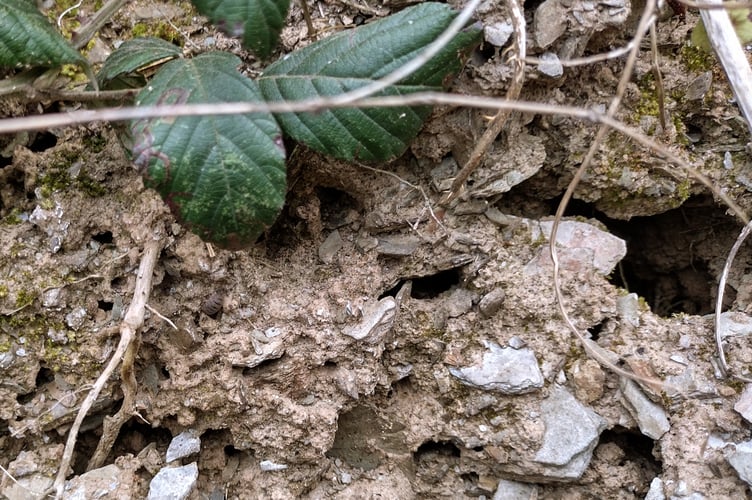A walk in early spring is one of the most sensory-rich experiences of the year for me. Each new flower unfurling its petals in response to those first fingers of warmth is like seeing a familiar friend, half-forgotten through the endurance of winter.
The sun was just up, veiled in mist, as I took one of my familiar paths. Primroses, like ruched lemon petticoats, swathed every verge and bank as I made my way along the lanes. Every so often, a vivid note of pink would reveal a red campion; a stalwart plant, often found flowering throughout the year. Now, more than at any other point through the seasons, the incredible three-dimensional structure of the near vertical and ancient Devon banks is visible.

Rocks plucked from surrounding fields, obstacles to horse and plough, stacked into dry stone-walls; a utilitarian solution serving both the need to clear them from the soil and get rid of them nearby. Earth, packed and wind-blown around this foundation allowed pioneer plants to colonise and tree seeds to take root. Centuries of routine maintenance as crop windbreaks, shelter for livestock and boundary markers inscribed many stories along their lengths, overwritten in more recent times by changes in agriculture, mechanised hedge cutting, urbanisation and neglect. Throughout each phase and change in fortune for these iconic structures, they have been utilised by wild plants and animals for their own purposes.
In my mind’s eye, I visualise the Devon bank as if in a virtual-reality fly-through, approaching from high in the sky where buzzards wheel and cry, looking down on connected lines through the landscape, joining patches of woodland, wetland and grassland; sightlines and corridors for those that fly, walk, creep, crawl and scatter seed. I see gaps and green lanes scarred by vehicle tracks; infill developments and neglect; unnatural greens where laurel and other ‘low-maintenance’ shrubs have replaced rich, diverse hedgerows where native trees were once coppiced, laid and tended over generations. I also see newly planted trees and brand new stone banks constructed along the scars of old ones; signs of hope that some lessons in our landscape are being heeded.
Zooming in closer towards a gnarled, sculptural oak, standing proud of the bank and grown huge from its humble beginning as a fallen acorn in leaf-litter, I can already hear birdsong: plump woodpigeons cooing love songs and chiff-chaff calling; the harsh rattle of a magpie. Knotty holes, ivy-covered branches and bark-scars bear imaginary labels saying ‘woodpecker nest’, ‘summer bat
roost’, and ‘beetle larvae gallery’. Touching twig-tips of hazel trees are labelled ‘dormouse route’, and twining honeysuckle, ‘dormouse nesting material’. Dipping down to the hedgerow shrubs, sounds intensify as blackcap melodies mix with the song-cycles of dunnocks and the sharp tick-ticks of an alarmed wren before bursting into its unfeasibly loud, whirring trill to stake out its territory. A deep buzzing rises from below as a buff-tailed bumblebee emerges from its earthen hole, appearing to hang heavy in the air as it searches for dandelions, rich in early nectar and pollen. Scanning the surface of the Devon bank, I notice minute insect holes pock-marking the bare earth, half-hidden mouse holes, and behind a lattice of twigs and ivy curtains, hedgerow highways, worn smooth by the traffic of small mammals going about their mainly nocturnal comings and goings.

Briefly, I admire the face of the bank in its early spring finery. Primroses steal the show, of course but I look closer and admire the juicy, green pennies of navelwort, delicate white flowers of greater stitchwort, and lesser celandine, with grey-backed petals until coaxed open by the sun into glossy, golden-buttercup starbursts. Bluebell and wild garlic leaf in abundance, in anticipation of the beauty and heady scents of their flowers, still to come. Lichens, mosses, fungi, liverworts, ferns and grasses layer and jostle in competition for resources. A Devon bank could be a microcosmic metaphor for our planet.
Finally, I indulge myself, taking a deep dive into the bank itself to imagine what life might be hidden there. Pushing through plant tussocks past overwintering invertebrates, egg cases and a sheltering frog on its pond-ward journey; burrowing into the earth to find beetles and bees, food stores exhausted, awaiting their time to emerge, feed and breed; and squeezing between the rocks, going deeper until I reach the insulated, now vacated, hibernacula of newts and slowworms deep in the bank. But still, I have only scratched the surface of this complex and fascinating ecosystem and I am only metres from home!
Abandoning my three-dimensional imaginings stimulated by winter’s revelations and burgeoning spring, I continue my walk in mindful and joyful observation, drinking in the morning’s sights, sounds smells and finally, tastes, as I cook up scrambled egg and foraged wild garlic for my breakfast.




